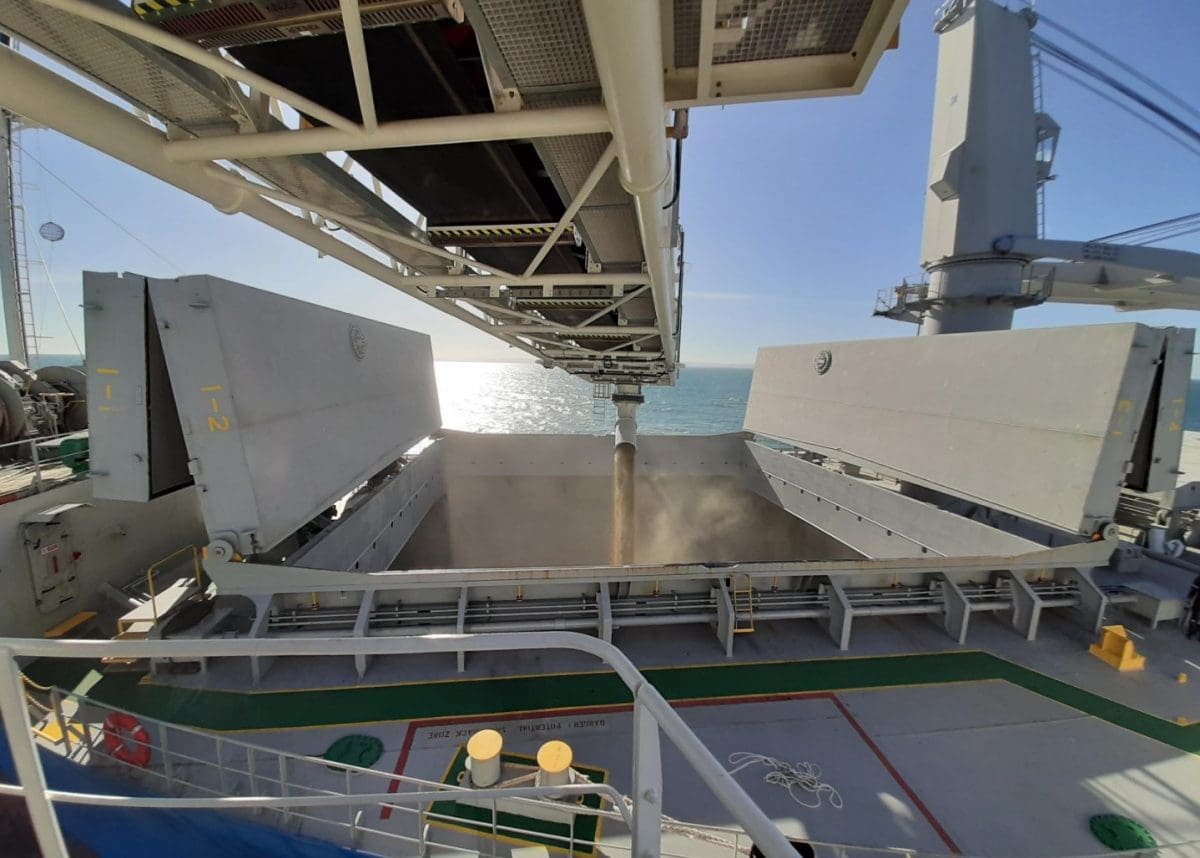
Grain shipped from South Australia and Western Australia, including this barley cargo which arrived in Brisbane earlier this month, is continuing to supply Queensland’s feed market. Photo: T-Ports
DRY CONDITIONS in Queensland and ideal showery conditions in much of south-eastern Australia appear to be balancing each other out this week to keep markets for current and new-crop wheat and barley largely steady.
Sources report volume traded has been minimal, as consumers now have adequate coverage which stretches at least to June and as far out as August for others.
The exception is sorghum, with its market trading at big inverses between prompt and June-July delivery and new-crop wheat.
Sliding yield prospects for the central Queensland (CQ) crop, inelastic demand from the poultry sector, and short-covering now in its fourth month are supporting sorghum values.
| This week | Last week | |
| Barley Downs nearby | $395 prompt | $403 July |
| Barley Downs Jan | $295 | $290 |
| Barley Melbourne nearby | $330 | $328-$330 |
| Barley Melbourne Jan | $280-$285 | $285 |
| Sorghum Downs Jun-July | $440 | $420-425 |
| Wheat Downs July | $493 | $502-$504 |
| Wheat Downs Jan | $340 | $345 |
| Wheat Melbourne nearby | $415 | $415 |
| Wheat Melbourne Jan | $330 | $330 |
Table 1: Indicative grain prices in AUD per tonne.
Quiet in south
Showers are forecast to continue into next week in South Australia, Victoria and southern New South Wales to bolster prospects for the crop now being planted.
Wilken Grain trading manager Andrew Kelso said the market had gone quiet in the past week, and new-crop values levelled out after softening late last week.
“Everyone’s already jumped in and bought May requirements for domestic and export,” Mr Kelso said.
“The market’s taking a breather, and growers are flat out with planting.”
Mr Kelso said Victoria’s customary winter-time reduction in cattle feeding for the beef and dairy sectors had trimmed grain demand for coming months.
Uncertainty in the beef market brought about by COVID-19, and a projected loss on feeder cattle, are expected to cut feedlot grain usage across the board in the near term.
Dry in north
The size of the CQ sorghum crop is shrinking with every day without rain.
While irrigated crops, and those that have had storm rain in the growing season, are looking at average yields, most dryland crops have lost up to one-third of their yield potential.
That means the region’s crop which looked likely to yield 300,000t is now expected to yield 200,000-220,000t at best.
Short covering in the April Brisbane track market has been occurring since Christmas at $500/t plus, and this week has been quoted at a new high of up to $545-$550/t.
Sorghum for prompt delivery to Goondiwindi or the Darling Downs has traded at $500-$515/t this week, which indicates shorts are active in up-country markets too.
On the Liverpool Plains, sorghum on-farm has traded at $445-$450/t, while growers on or north of the Queensland border are getting $500/t on farm.
“The May-July sorghum market is pretty much in record territory, and April is even higher,” Delta Ag broker Tom Vanzella said.
“Sorghum is $80-$90 above new-crop wheat, and that has to indicate a very tight supply.
“The volumes are a lot lower than the market had hoped for.”
Dry conditions in CQ have also generated concerns about planting the wheat crop the market could usually expect to be accessing in September-October.
“There will be planting of chickpeas into subsoil moisture, but CQ needs a decent rain to get a good wheat crop in.”
Many southern Queensland growers are in need of rain to get their wheat and barley planted, but northern NSW growers have generally made good progress with their seeding programs.
Mr Vanzella said some growers have forward sold up to 15 per cent of their new-crop based on conservative yield estimates.
On the Liverpool Plains, some growers earlier this month sold new-crop barley at $250/t on farm and wheat at $320/t, and this week’s values are down about $15-$20/t from those levels.
Cottonseed flat
“Cotton defoliation has begun but the crop is late,” Woodside Commodities manager Hamish Steele-Park said.
“Values remain static for both the 2020 and 2021 seasons.”
Cotton merchants would expect some ginning in northern NSW to begin at the end of April and gins in the south to get under way in the middle of May.
Grazier demand for cottonseed has slowed to a trickle and beef feedlots appear to have adequate cover.
ASX May down, January up
ASX futures saw new-crop 2021 and red-crop 2022 futures rise, and current-crop prices fall.
As nearby futures continued to slide, May 2020 barley settlement yesterday was $296/t, 3pc below a week earlier. May 2020 WM east coast wheat yesterday settled at $399/t, 0.5pc lower than a week earlier.
January 2021 wheat and barley settled around $5/t firmer than a week ago, yesterday settling at $276.30/t and $333/t respectively.
January 2022 wheat lifted, approaching levels it had traded at the beginning of the month. It settled yesterday at $325/t.
